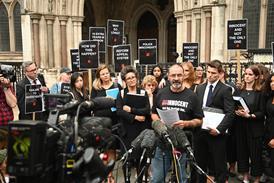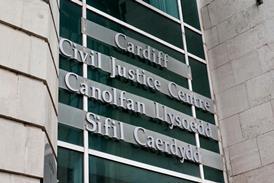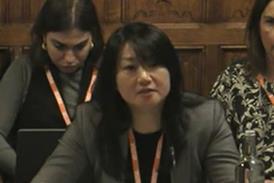On 25 October Jamie Rafferty, a solicitor employed by a City firm, was fined £2,500 by the Solicitors Disciplinary Tribunal following a conviction for failing to provide a breath sample. Although that decision is superficially unremarkable, the story behind it shows that the regulatory regime set up in the Legal Services Act 2007 is now unfit for purpose, and that the Solicitors Regulation Authority is abusing the statutory powers entrusted to it by parliament. Had the SRA been given unlimited fining powers, it would have fined Rafferty around £50,000, a blatantly unfair penalty.

SRA and the Rafferty case
The SRA took over from the Office for the Supervision of Solicitors in 2007. It is structurally part of the Law Society but is operationally entirely independent. In
2010, the SRA gained the power to fine solicitors up to £2,500, and immediately agitated for increased powers. These were granted in 2022, with the statutory limit raised to £25,000. Immediately, the regulator again agitated to remove any limit upon its fining powers.
This has been a sustained ‘power grab’ by the SRA at the expense of the SDT. Whereas the SRA is prosecutor, judge and jury in its own cause when dealing with solicitors in-house (and makes those decisions on paper rather than by way of a public hearing), the SDT is an independent and impartial tribunal which does its work in public, and is properly accountable and properly scrutinised by the High Court on appeal.
For years I have railed in these pages against the SRA’s unfair in-house system, warning that providing the SRA with such powers without any proper accountability was a recipe for disaster. Nobody took much notice. But when I saw how the SRA was exercising its increased powers, I was very concerned.
In January 2024, for no apparent reason, the SRA unilaterally decided to increase drink-driving fines exponentially for solicitors who had already been dealt with in the criminal courts. Two solicitors were suddenly fined more than £10,000. Christopher Houssemayne du Boulay and I wrote Gazette articles criticising those decisions (see: Double jeopardy: SRA's £14k drink-drive fine is unfair and Huge fines show SRA is misusing its powers). Shortly after my first article, the SRA imposed a fine which seemed to me to be unduly lenient – I was confident that the SDT would have suspended or struck off the miscreant solicitor – and again I criticised the SRA’s in-house fining regime. Although invited to do so, neither the SRA nor the Law Society responded to either of my articles.
Within a few days of writing the first article, I received a communication from Jamie Rafferty.
He had pleaded guilty in the magistrates’ court to failing to provide a breath sample and had been fined £3,846. It was a standard case with no aggravating features. He duly reported his conviction to the SRA. Rafferty told me that the SRA was looking to fine him around £50,000. I found this hard to believe and asked him to send me the papers. He was right. It turned out that using its mathematical approach to fining solicitors, the SRA had concluded that the starting-point fine for Rafferty should be £67,500, reduced to almost £50,000 thanks to mitigation which was calculated at a mysteriously accurate 27% (I can assure readers that I am not making any of this up). I considered that a potential fine of £50,000 was ludicrous and suggested to Rafferty that he take his chance before the SDT rather than try to negotiate further with the SRA.
For many years before January 2024 the SRA and SDT, and indeed the regulatory authorities for the bar, had imposed modest fines rarely exceeding £3,000 on those convicted of drink-driving, whether the offence was driving with excess alcohol or failing to provide a specimen. In June 2024, following the criticism referred to above, the SRA issued a consultation paper in which it made clear that it was going to revert to its earlier practice. It stated: ‘We consider it is no longer appropriate to impose a financial penalty for drink driving.’ I looked forward with some confidence to hearing that the SRA was going to suggest a sensible resolution of Rafferty’s prosecution, as its belief that the case merited a fine of more than £25,000 was now completely unsustainable. I waited in vain.
The case was heard by the SDT, which rejected the SRA’s allegation of lack of integrity against Rafferty and imposed a fine of £2,500. Its written judgment eventually emerged in late January 2025.
Solicitors now have a system of regulation in which there are two disciplinary authorities, the SRA and SDT. The SRA, as the more junior authority and inexperienced in imposing disciplinary sanctions, might have been expected to adopt the tried and tested sanctions guidance published by the SDT. Not a bit of it.
The SRA devised its own fining guidance, aping the approach taken in the financial services industry, and plainly designed to be more draconian than the SDT’s fining regime. Solicitors now have two disciplinary authorities, the junior of which, the SRA, plainly considers that it has a superior approach to that of the more senior and experienced body, the SDT, which is entrusted with far more extensive powers by parliament than the SRA. The SDT is properly accountable, with an appeal to the High Court available to both sides without needing to obtain permission. The SRA has far more extensive powers over alternative business structures and those who work in them than it has over solicitors in conventional law firms. As I submitted to the SDT in the Rafferty case, the topsy-turvy dual system that has developed ‘is completely illogical, completely unfair, and completely mad’.
Since its creation in 2007, the SRA has not developed a satisfactory relationship with the profession or the Law Society. Under Antony Townsend, it sought to adopt a more consensual style of regulation for a time, but it was felt in some quarters of the organisation that this was too ‘soft’. Under Paul Philip, it has reverted to more of a traditional role as the profession’s policeman. But those who have to deal with it tend to find it generally unsympathetic to the realities of practice as a solicitor, and tin-eared, as well as extremely slow to deal with cases. Its high-handed response to the last year’s Axiom Ince report was ill-advised. A little humility here and there would do it no harm, but unaccountability and arrogance tend to walk hand in hand.
There is also an uncomfortable feeling that the SRA is far too easily influenced by the government of the day. Rarely a week goes by without a significant fine being imposed on a law firm by the SRA for breaches of the anti-money laundering regulations, even though there is rarely, if ever, any suggestion that money laundering has actually occurred. Some of the AML cases brought by the SRA before the SDT have failed altogether. The pressure on the SRA to ‘clamp down’ can only have come from government sources.
Looking further back, the disciplinary proceedings in the miners’ compensation cases and the unsuccessful prosecution of Leigh Day plainly arose, in part at least, from pressure placed on the regulator by MPs. MPs generally tend to support ever greater SRA in-house powers, without perhaps having the slightest idea how those powers are being exercised in practice.
Law Society
My impression is that since it lost most of its regulatory powers to the SRA in 2007, the Law Society has struggled to fulfil its principal remaining role as representative of the solicitors who make up the profession. It was telling that the critical responses to the SRA’s June 2024 consultation paper were led by the local law societies, that is the City of London Law Society (through Iain Miller) and the Birmingham Law Society (through Jayne Willetts). The national Law Society was third in the queue when it might be thought that it should have led the charge.
Why is there this reticence by the Law Society? I am grateful to Nigel West and Linda Lee, both of Messrs Weightmans (and the latter an ex-president of the Society), for explaining to me the difficult position in which the Law Society has been placed. By rule 2 of the Legal Services Board’s Internal Governance Rules 2019, the Law Society, as an approved regulator with representative and regulatory functions, must delegate the discharge of its regulatory functions to a separate body (the SRA) and, after delegation, must only retain a role to the extent that it is reasonably necessary to be assured that the regulatory functions are being discharged in compliance with section 28 of the Legal Services Act 2007 or as otherwise required by law.
In 2018, the LSB severely criticised and publicly censured the Law Society for ‘serious breaches’ of the previous Internal Governance Rules. The then interim chair of the LSB, Dr Helen Phillips, did not hold back: ‘The complexity, ambiguity and burdensome nature of TLS’s monitoring and oversight arrangements for the SRA were unacceptable. Its actions have impaired the effectiveness of the SRA… For a body which emphasises the importance of the rule of law, this is a serious failing.’
So the Law Society was being publicly censured for trying to hold the SRA to account. The unmistakable message from the LSB was ‘hands off the SRA’. Before the Axiom Ince debacle, the LSB generally took a notably pro-SRA line, for instance siding with it over the adoption of the civil standard of proof for the SRA’s in-house adjudications (against the wishes of the then master of the rolls Sir Anthony Clarke) and the increase in its fining powers.
The overall result is that the Law Society has been unable to hold the SRA properly to account, and that, until the Axiom Ince report, the SRA was given more or less a free ride by the LSB. Since 2007, it has been impossible to give a reassuring answer to the question of who regulates the regulator.
Legal Services Board
The LSB has been comparatively invisible to the profession, perhaps inevitably as it interacts principally with regulators rather than with individual solicitors or the public. Nevertheless, the LSB sprang into the limelight last year when it commissioned and then released an independent report into Axiom Ince. The report was highly critical of the SRA and the LSB stated that it was going to take further action. It has not yet explained what that action will be or when it will be taken.
Although, like most readers, I have little day-to-day experience or knowledge of the LSB, I have to say that publicly available documents issued by the LSB do not fill me with confidence. I can provide two examples.
In 2021, the board produced a superficially impressive document, Reshaping legal services: a sector wide strategy, containing coloured graphs and charts aplenty. Its ‘3-year strategic priorities’ were said to be ‘Identifies priority areas of focus; Invites sector leaders to say how they will contribute; Describes where the LSB will contribute’. That would appear to be an extremely thin list of ‘strategic priorities’ to cover three years.
I then looked at the LSB’s February 2024 Regulatory Performance Assessment, which assessed the performance of each legal services regulator against the LSB’s regulatory performance framework. It gave the SRA a clean bill of health, but unfortunately the document is written in the most indigestible and impenetrable prose, covered in a thick coat of jargon which renders it almost unreadable.
One passage under the heading ‘Overall Themes’ illustrates this: ‘In this year’s assessment, which focused on our Well-led and Effective approach to regulation standards, we found that issues around regulators’ transparency, capacity and capability, using and deploying evidence and enforcement persist, but in different ways and to different degrees. We also identified a new theme in relation to the effectiveness of regulators’ horizon scanning and risk monitoring capabilities.’
Who writes this stuff and what does it mean? Why could it not have been expressed in ordinary English?
Possible solutions
For the reasons set out above, I consider the system of regulation of the solicitors’ profession that has developed since 2007 to be unfair and inefficient. I would propose the following reforms to help cure the problems which I have sought to identify:
1. The Law Society should become structurally independent of the SRA and lose its remaining regulatory responsibilities. This would enable it to concentrate on its other activities, most importantly its role as a voice for the profession and as a representative body for solicitors, able sometimes to seek to hold the SRA to account.
2. The SRA should lose its statutory power to fine any individual or entity (whether a traditional law firm or an ABS) more than £2,500. This would enable it to revert to its important role as promulgator of guidance to the profession, and investigator and prosecutor where it sees potentially non-compliant behaviour. This would leave the SDT as the independent and impartial tribunal to determine all professional misconduct enforcement issues, save for the trivial.
3. In the alternative to 1) and 2) above – and although I quail at the prospect of yet another quasi-regulatory body in an already crowded field – I would like to see an independent complaints body chaired by a retired judge or similar, set up to deal with complaints by those (whether complainants or legal professionals) who consider that they have been badly dealt with by the SRA or any other legal regulator.
4. Those who write reports for the LSB should be sent on a course to teach them to write plain English.
I am sure others will have better ideas, and it is time for fresh thinking and fresh energy to be brought to bear on these issues. I have been drawing attention to them for several years, with precious little to show for it. If the SRA and the Law Society will not engage in this debate, I hope that someone, somewhere, will pick up the torch, because the solicitors’ profession deserves a far better system of regulation than it currently ‘enjoys’.
Gregory Treverton-Jones of 39 Essex Chambers specialises in regulatory and disciplinary issues concerning legal professionals. He has co‑authored successive editions of The Solicitor’s Handbook
This article is now closed for comment.





























7 Readers' comments